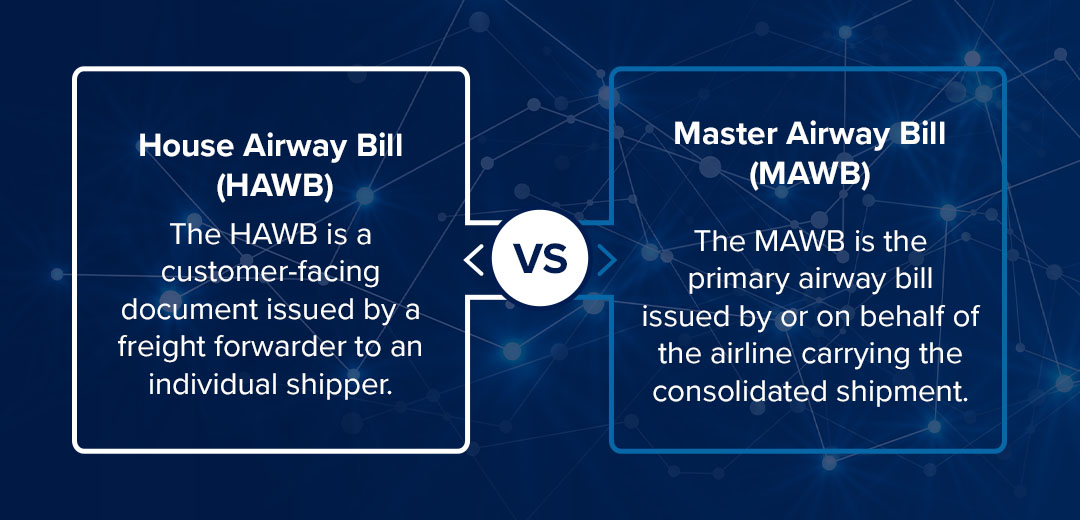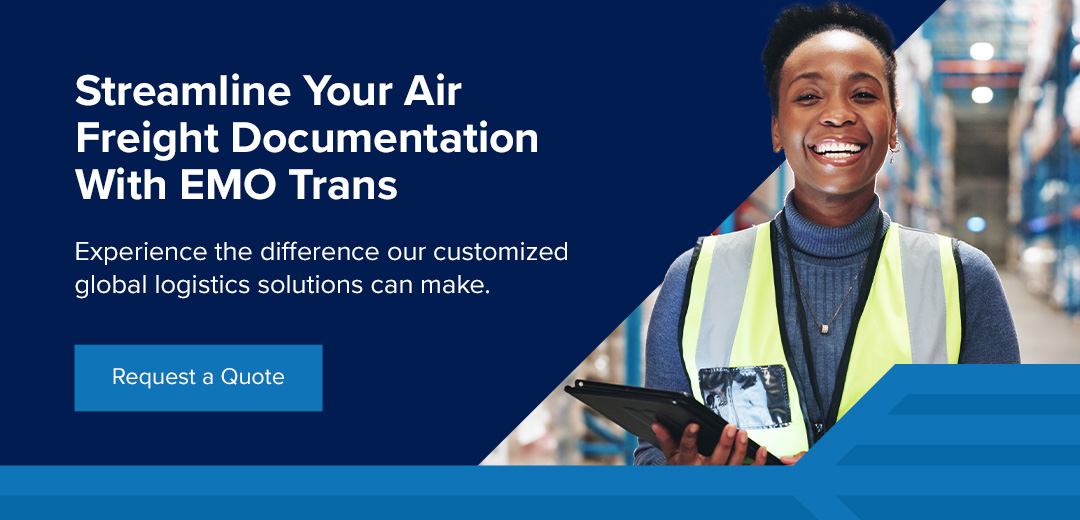
International air freight operations rely heavily on accurate documentation for smooth logistics. One crucial document in this process is the airway bill (AWB). This comprehensive guide explores the meaning of AWB in shipping, including defining AWB, its types, components and significance in global trade.
What Is an AWB?
An airway bill, also known as an air waybill, is a legally binding contract between the shipper and the air carrier or their agents for transporting goods. The AWB in shipping covers several crucial functions, including:
- Confirming that the carrier has accepted the goods and agrees to deliver them to the consignee
- Providing detailed information about the shipment, including contents, weight and dimensions
- Serving as a customs declaration for international shipments
- Enabling shipment tracking throughout its journey
An airway bill shipment document is typically nonnegotiable, meaning it cannot be transferred to another party by endorsement. This characteristic distinguishes it from a bill of lading used in ocean freight.
With the advent of electronic data interchange (EDI) systems, many carriers now offer electronic airway bills (e-AWB). This digital format streamlines the shipping process, reduces paperwork and minimizes errors.
What Are the Parts of an AWB?
The main components of an air waybill include:
- Shipper and consignee information: Include the complete names, addresses and contact details for both parties.
- Issuing carrier: This is the name and IATA code of the airline responsible for the shipment.
- An airbill number: An airbill number is a unique 11-digit number that identifies the shipment. The first three digits represent the airline’s code, followed by a seven-digit serial number and a check digit.
- Airports of departure and destination: Use official IATA three-letter airport codes.
- Flight details: Include flight numbers, dates and transfer points.
- Description of goods: This should be a clear, concise description of the shipped items, including quantity, weight and dimensions.
- Special handling instructions: Include any specific requirements for handling shipment due to hazardous materials, fragile content, contamination concerns or other factors.
- Charges: Include a breakdown of all applicable fees, including freight charges and additional services.
- Customs information: Include Harmonized System (HS) codes and country of origin.
- Signatures: There should be signatures from the shipper and the carrier.
HAWB vs. MAWB

Air freight has two primary types of airway bills — the House Airway Bill (HAWB) and the Master Airway Bill (MAWB). Understanding the distinction between HAWB and MAWB is crucial for effectively managing complex air freight shipments.
The HAWB is a customer-facing document issued by a freight forwarder to an individual shipper. It is a contract between the forwarder and the shipper, covering a specific shipment that may be part of a larger consolidated cargo shipment. Logistics companies that consolidate multiple shipments create HAWBs, each containing specific details about an individual shipment within the consolidated load. A HAWB features detailed shipment information and has a unique numbering system.
HAWBs are particularly useful when multiple shipments from different shippers are combined into a single freight shipment. This practice, known as groupage, allows for more cost-effective transportation of smaller shipments.
MAWBs are crucial for the management of consolidated air freight shipments. They provide a single reference point for customs authorities and airlines, simplifying handling for multiple individual shipments traveling together.
How to Complete an AWB
Accurate completion of an air waybill is crucial for several reasons. The AWB is a legal document, and inaccuracies can lead to disputes or compliance issues. Precise information also facilitates smooth customs processing, reducing the risk of delays or inspections. Correct shipment details in the AWB ensure proper shipment handling throughout its journey. The AWB is also used for invoicing, so inaccurate information can lead to incorrect charges or payment disputes. Additionally, the airbill number is essential to tracking shipments, and errors can make tracing difficult or impossible.
- Enter complete and accurate shipper and consignee names, addresses and contact details for both parties, including reference numbers or account codes if applicable.
- Provide the name and IATA code of the airline carrying the shipment. Include the agent’s name and IATA code if using a freight forwarder.
- When filling out the departure and destination airports, use the official three-letter IATA airport codes. If the shipment involves multiple flights, specify transfer points.
- Provide a clear, concise description of all shipped items, including the number of pieces, gross weight and shipment volume. Specify information on hazardous materials or special handling requirements.
- Break down all applicable fees, including freight charges, fuel surcharges and additional services. Indicate whether charges are prepaid or collect.
- Enter the correct HS codes for the goods and provide the country of origin and export license numbers if required.
- Ensure shipper and carrier signatures are present, and include necessary declarations, such as those for dangerous goods or security status.
Double-check all information for accuracy before submitting the AWB. Even minor errors can lead to significant shipping delays or complications.
Who Needs to Fill out an AWB?
The responsibility for completing an airway bill falls on different parties depending on shipment type and arrangements, including:
- Shippers: In cases of direct shipment, the shipper may complete the AWB themselves, especially when dealing directly with an airline.
- Freight forwarders: For consolidated shipments, freight forwarders usually complete the MAWB and individual HAWBs for each customer’s goods.
- Airlines or their agents: When shippers book directly with an airline, the carrier or their authorized agent may fill out the AWB based on information provided by the shipper.
- Online platforms: Some airlines and logistics providers offer online platforms where shippers can automatically fill their AWBs, subject to verification.
- Third-party logistics providers (3PLs): When managing shipments on behalf of clients, 3PLs often take responsibility for AWB completion.
Who Issues an AWB?
The AWB issuing party can vary depending on the shipment type and arrangements. Generally, the following parties issue AWBs:
- Airlines: When shippers book directly with the carrier, the airline or its authorized agent typically issues the AWB.
- Freight forwarders: In consolidated shipments, freight forwarders issue the master and house airway bills.
- IATA-accredited cargo agents: These authorized agents can issue AWBs on behalf of the airlines they represent.
- Customs brokers: In some cases, customs brokers may assist in issuing AWBs, especially for complex international shipments.
- 3PLs: When managing shipments for clients, 3PLs often handle AWB issuance as part of their service.
Streamline Your Air Freight Documentation With EMO Trans
EMO Trans offers unparalleled expertise in global logistics solutions, including comprehensive air freight services. With our custom-tailored solutions and commitment to excellence, we can help streamline your documentation processes and enhance your shipping experience. Whether you need assistance with a HAWB, MAWB or other aspects of airway bill shipment management, our team is here to help.
Request a personalized quote today, and experience the difference our customized global logistics solutions can make.

